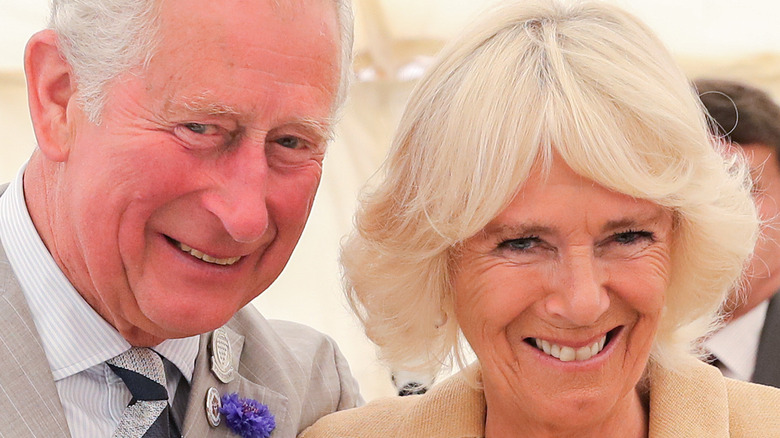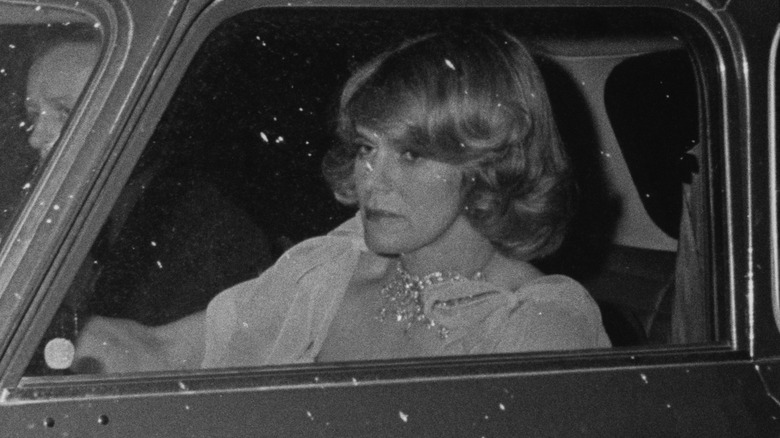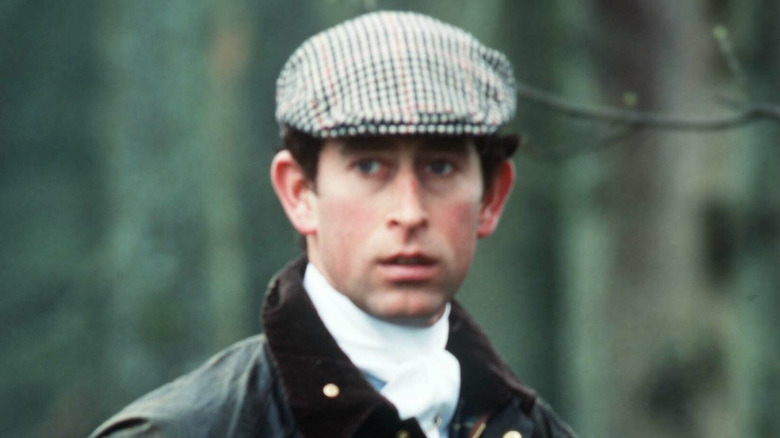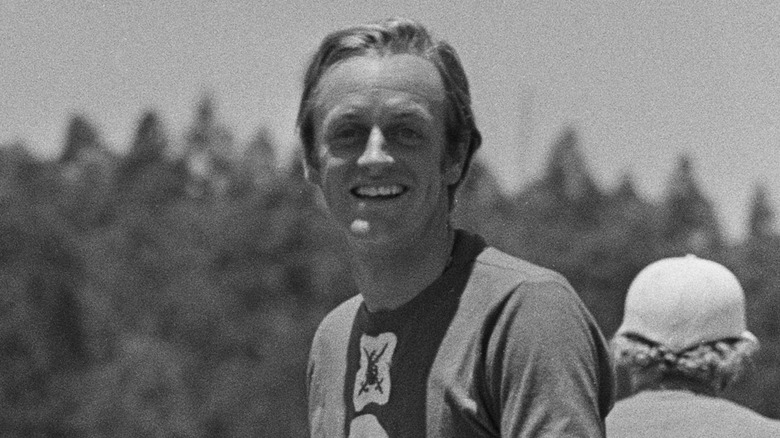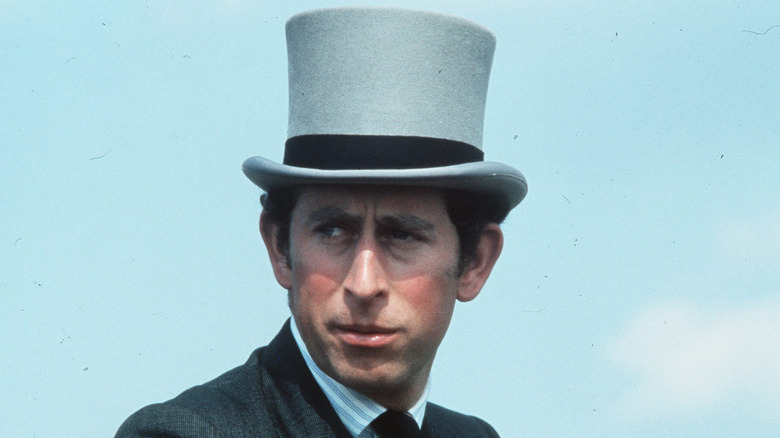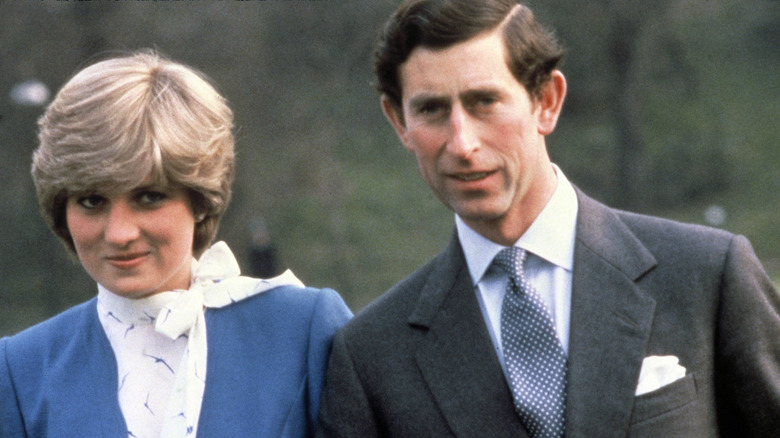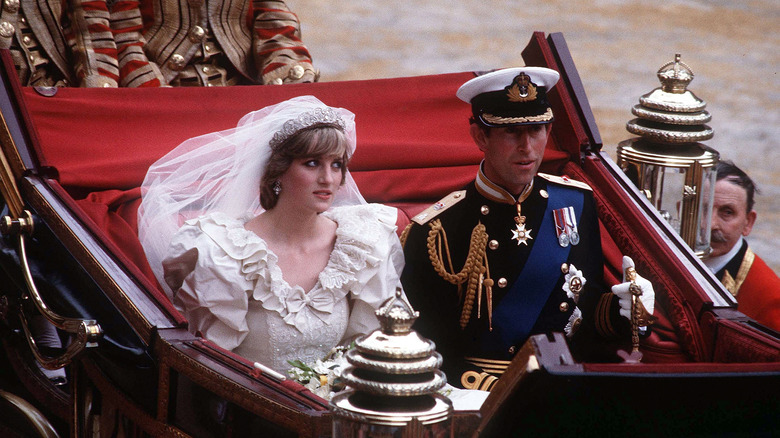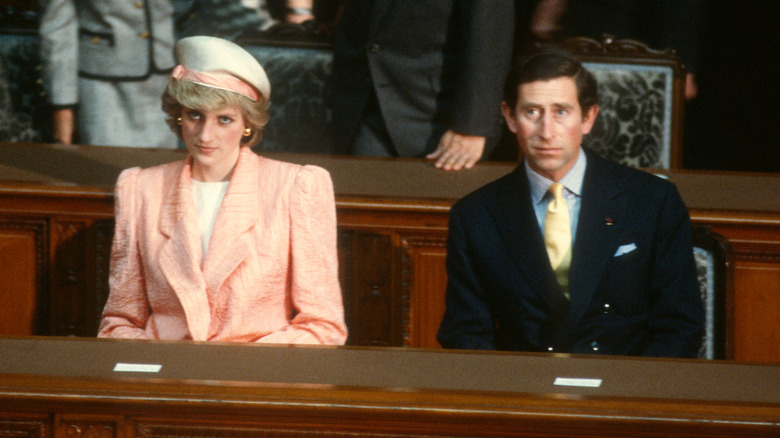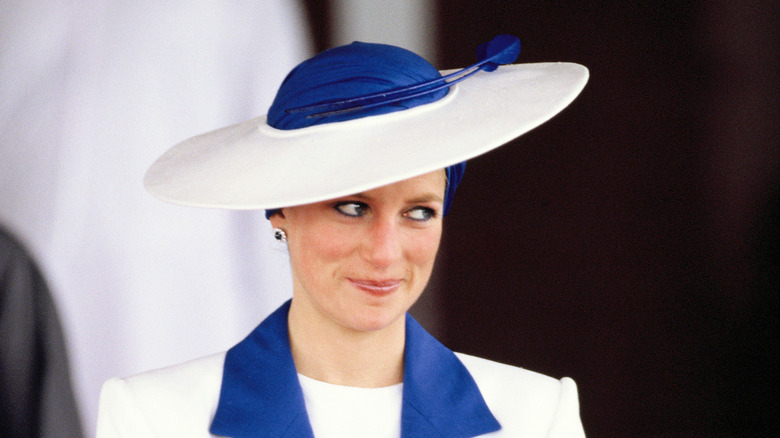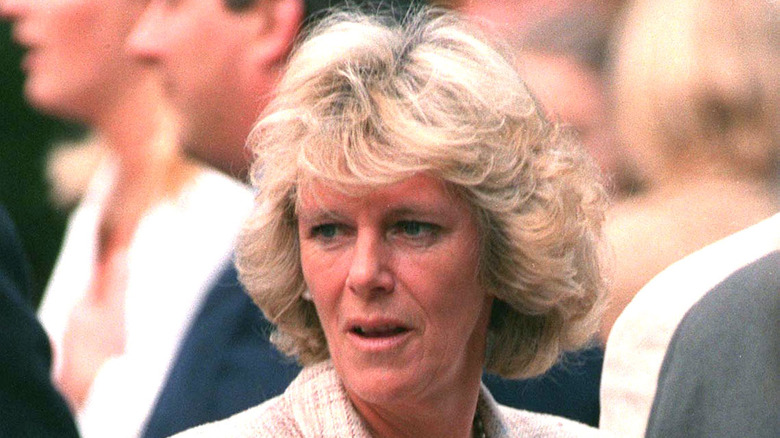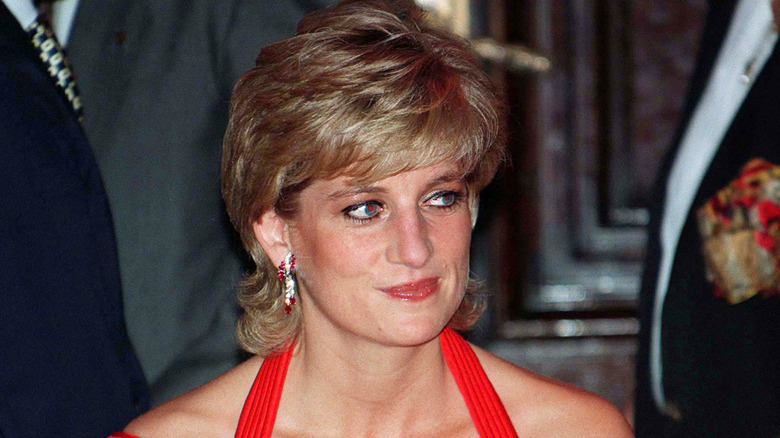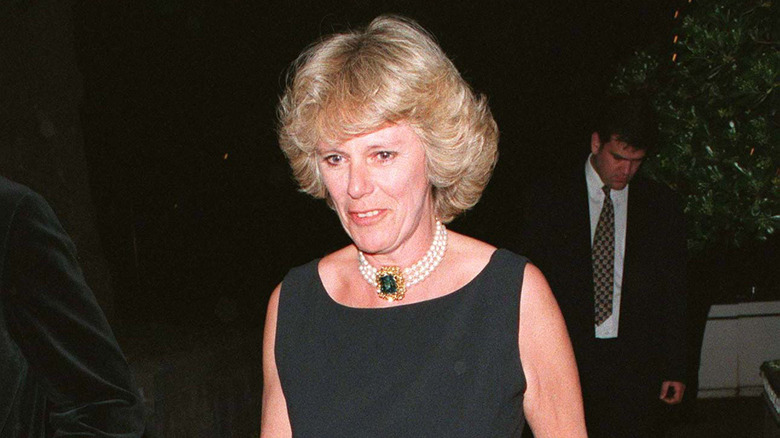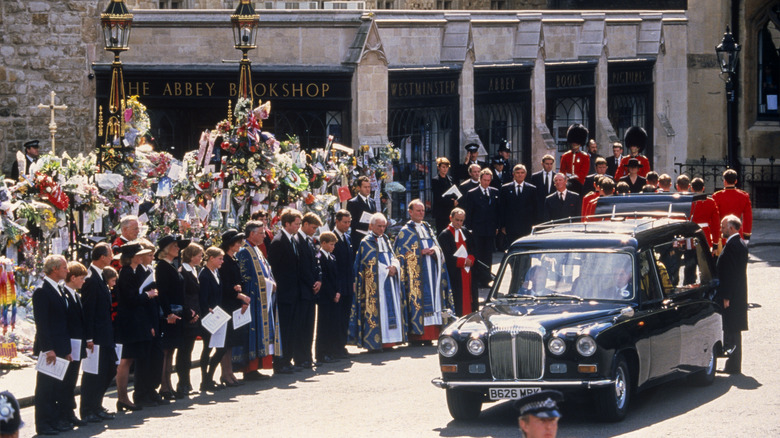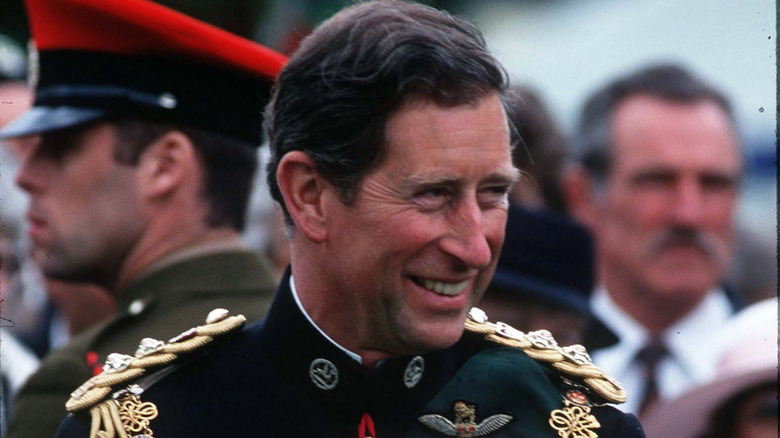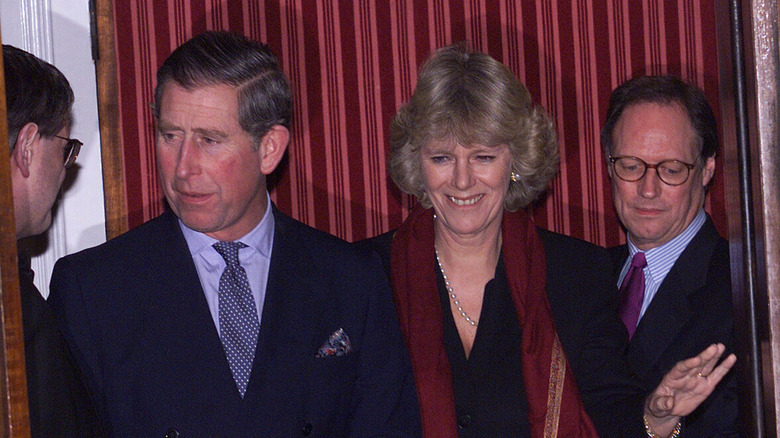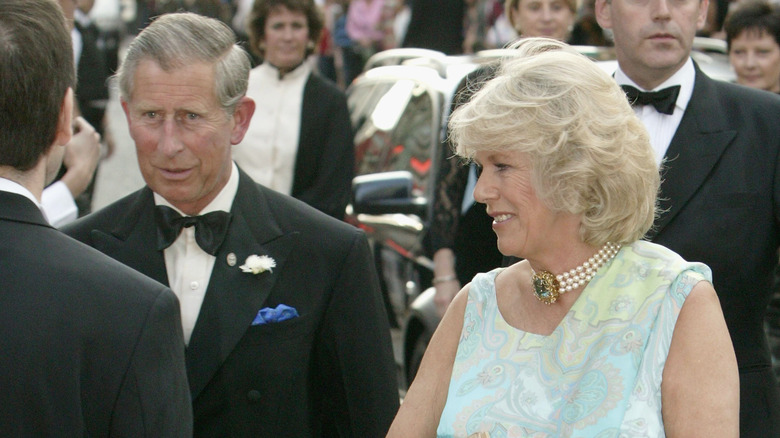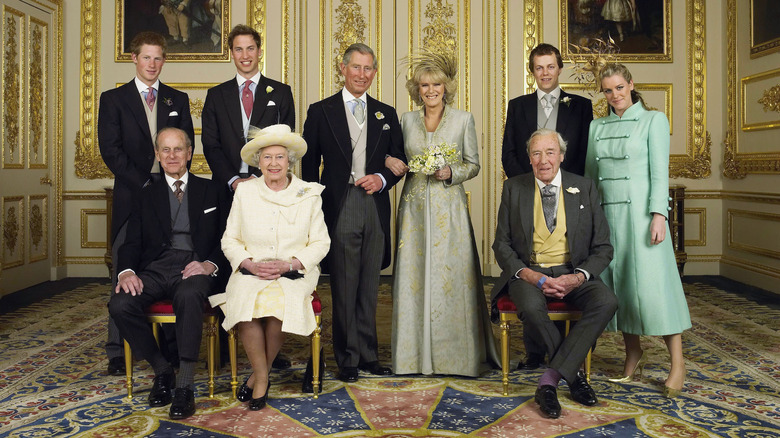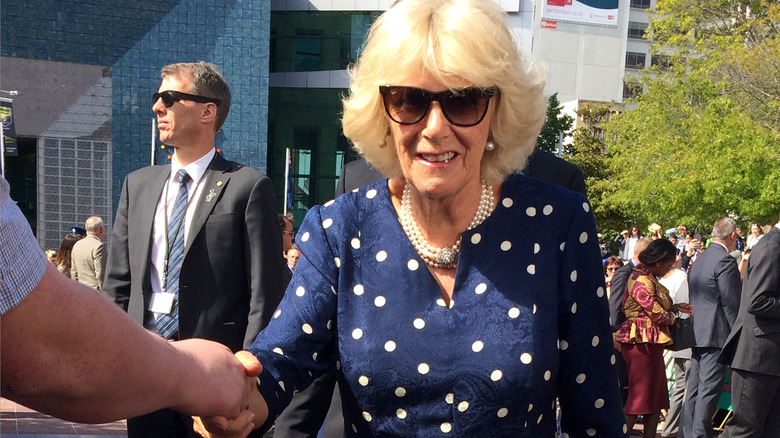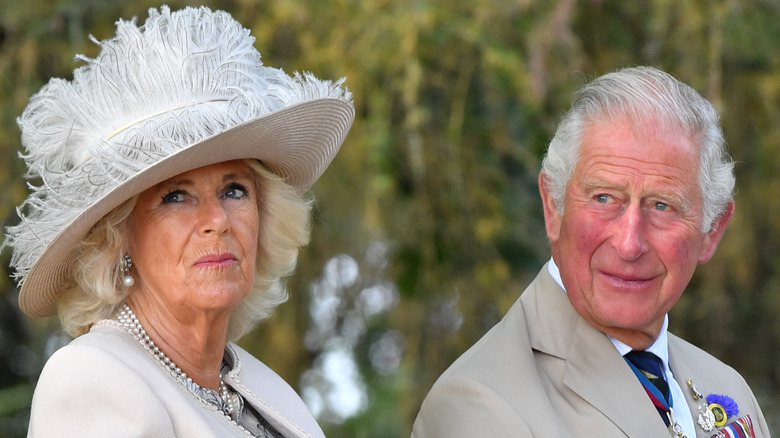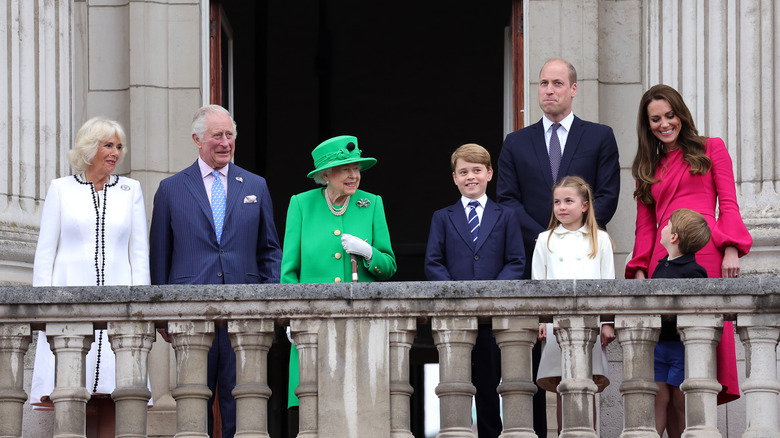A Complete Timeline Of King Charles III And Queen Consort Camilla's Relationship
To say that the royal family is the gift that keeps on giving is an understatement. While the monarchy is known for its charitable work and its representation of the Commonwealth on the international stage, intrigued masses look to the firm for its daily dose of drama — and this is nothing new. Royal scandals are just as old as the monarchy itself, with more modern dramatic episodes taking all forms.
Take King Edward VIII's abdication from the throne for example — the newly minted king realized that he couldn't rule and marry the love of his life, American divorcee Wallis Simpson, so he simply gave up the crown, throwing his younger brother into the spotlight and onto the throne all in one swoop. Additionally, Princess Margaret, Queen Elizabeth's sister, was known for her illicit affair with Peter Townsend, and don't even get us started on Prince Andrew.
Of course, we can't talk about royal scandals without revisiting the cream of the crop — King Charles III's affair with Queen Consort Camilla. The two were infamously joined at the hip throughout their marriages to other people and their affair has been the subject of much public ire. While they continue to make the headlines — and will do so for quite some time — we're taking a deep dive into their relationship and going all the way back to the beginning. How did these two meet? When did their affair start? How did they combat such public outrage during their romance? This is the complete timeline of Charles and Camilla's relationship.
King Charles III and Queen Consort Camilla first crossed paths in 1971
To tell the story of King Charles III and Queen Consort Camilla, we have to go all the way back to 1971. As told by James Panton and Kenneth John Panton in their 2011 book, "Historical Dictionary of the British Monarchy," Charles and Camilla first crossed paths at a polo match — this certainly doesn't come as a shock, given Charles' affinity for the game and Camilla's passion for all things equestrian-related. The authors attested to Camilla's unabashed approach to the then-prince, noting that she was the pursuer.
In a very daring example, Camilla approached Charles in a nightclub following their initial meeting, taking the opportunity to present the "historical" reason why they should spark a romance. "My great-grandmother was your great-great-grandfather's mistress, so how about it?" she said at the time. From then on out, the two were often seen together, with Charles admitting that their early romance was "blissful, peaceful, and mutually happy," writes Penny Junor in her book, "The Duchess: Camilla Parker Bowles and the Love Affair That Rocked the Crown" (via Vanity Fair).
Of course, things didn't stay all sunshine and rainbows for the couple.
The royal family did not approve of Camilla as a suitable match for Charles
Given that King Charles III and Queen Consort Camilla dated in the 1970s, maintained an affair throughout their marriages, and eventually tied the knot themselves, many people have wondered why they didn't just marry each other in the first place. Those aforementioned external forces had something to do with it. In the ITV documentary, "The Real Camilla: HRH the Duchess of Cornwall," it was noted that Lord Mountbatten — Prince Phillip's uncle and a close family member to Charles — was not a fan of the relationship between the heir to the throne and Camilla. She was, as it turned out, seen as too much of an experienced woman who was not suitable for the royal family.
"They had a little fling in 1972, but Lord Mountbatten advised Charles: 'lovely for you two to have a fling, but this absolutely cannot end in marriage,'" a spokesperson attested to in the documentary, per Express.
So what was it exactly that the royals didn't like about Camilla? In those early days, the now Duchess of Cornwall was "very lively, very pretty" and "drank copiously" with the people who "enjoyed being in her company," the ITV documentary found. But the royals saw her as a "nonstarter" given her boldness and reputation, and they worried that she would not be looked at as "aristocratic" enough for the then-prince, per Reader's Digest.
Camilla married Andrew Parker Bowles in 1973, but her relationship with Charles continued
It seemed as though King Charles III and Queen Consort Camilla were simply not meant to be, and their early relationship in the 1970s fizzled as Charles pursued his naval career. When he returned from his naval post, Charles learned that Camilla and Andrew Parker Bowles — her longtime boyfriend — were finally tying the knot, and the prince was said to be devastated. After docking in Antigua and learning the news, Charles wrote to friend, "I suppose the feeling of emptiness will pass eventually," noting that he no longer had someone to return to, per the Daily Mail.
And so it was — Camilla and Andrew married at the Guards' Chapel on July 4, 1973, with the Queen Mother and Princess Anne in attendance no less. Camilla's marriage was not enough, however, for her to stop seeing the heir to the throne. According to the ITV documentary, "The Real Camilla: HRH the Duchess of Cornwall," Camilla quickly returned to Charles' gaze, given Andrew's own infidelity (via Express). "She was unhappy that she was the betrayed woman," a source revealed in the documentary. "This was the real problem. That's what sent her back into the arms of Prince Charles."
The two remained inseparable throughout the 1970s
In the 1970s, King Charles III, then Prince Charles, was one of the most eligible bachelors, as he was heir to the British throne and had yet to tie the knot. And while he was seen as single and ready to mingle, Charles maintained his relationship with the then-married Camilla, with the two continuing to chat regularly. While Camilla was pregnant with her first child, she and Charles would make it a point to see one another at polo events, the Daily Mail reported. When her son, Tom Parker Bowles, was born, Charles even became his godfather.
Throughout the 1970s, Charles and Camilla made it a point to ride together, frequently enjoying the outdoors at the Badminton estate. They spent so much time together, in fact, that Charles purchased Highgrove Estate — located in Gloucestershire — because, for one reason, it was situated close to Camilla's residence (via Daily Mail).
By 1977, Camilla was pregnant with her second child, but shortly after welcoming baby No. 2, Charles and Camilla reignited their romantic relationship. This was, in part, because Camilla "gave up" on her husband, Andrew Parker Bowles, who had a sordid reputation all his own, a friend of Camilla is quoted as saying in the Daily Mail. The publication further noted that Charles and Camilla were once again romantic with one another by 1978, though mostly behind closed doors.
Charles proposed to Diana Spencer in 1981, but quickly cast doubt on their relationship
King Charles III was in a bit of a predicament — he was in love with a married woman, Queen Consort Camilla, then Camilla Parker Bowles, but knew he needed to get married eventually. Cue Diana Spencer, the 19-year-old who was all but chosen for the then-prince. After only a dozen or so dates, Charles proposed to Diana, and the United Kingdom quickly celebrated their future king and queen.
When asked by journalists at their engagement announcement if they were in love, Diana promptly responded, "Of course." Charles, however, said, "Whatever 'in love' means." If that wasn't an admission of lackluster feelings, we don't know what is. As it turns out, Diana was "traumatized" over the remark, and revisited the very moment in the documentary, "Diana: In Her Own Words" (via Marie Claire).
Diana revealed that she went to Charles' mother, Queen Elizabeth II, for help shortly thereafter. As Diana recalled, "I went to the top lady, sobbing and I said, 'What do I do? I'm coming to you, what do I do?' And she said, 'I don't know what you should do, Charles is hopeless.' And that was it, that was help" (via Daily Mail).
Camilla was on Charles' mind in the lead-up to his wedding to Diana
It was the wedding of the century, but the then-Prince Charles wasn't particularly attentive to his bride, the young Diana Spencer, in the lead-up to their nuptials. As Andrew Morton wrote in Diana's biography, "Diana: Her True Story," Charles had Camilla on his mind just days before his wedding, even having a bracelet specially made for her — as it turns out, Diana discovered the package via Charles' secretary, Michael Colborne.
"I was still too immature to understand all the messages coming my way. And then someone in his office told me that my husband has had a bracelet made for her. I walked into this man's office one day and I said, 'Ooh, what's in that parcel?' And he said, 'Oh, you shouldn't look at that,'" Diana recalled. "So I opened it and there was the bracelet." The piece of jewelry in question was a gold bracelet featuring the letters F and G — a nod to the nicknames that Charles and Camilla had for each other, Fred and Gladys respectively.
"I was devastated, and I said, 'Well, he's going to give it to her tonight,'" Diana continued to Morton. "So rage, rage, rage. You know, 'Why can't you be honest with me?' But no, he cut me absolutely dead. It's as if he had made his decision, and if it wasn't going to work, it wasn't going to work."
Charles rekindled his romantic relationship with Camilla in 1986
What started off as a seemingly fairytale romance between then-Prince Charles and Diana Spencer quickly soured. The two were at odds from the very beginning, and rumors about infidelity, a lack of support, and — of course — Camilla plagued the marriage. By 1986, five years after Diana and Charles married, the prince had rekindled his romantic relationship with Camilla, a fact of which Diana was keenly aware.
In an ITV interview conducted with Jonathan Dimbleby, which aired in 1994, Charles finally admitted to the 1986 affair and the reignited love between himself and Camilla, telling Dimbleby that he was faithful to Diana until they reached a breaking point. "Did you try to be faithful and honorable to your wife when you took on the vow of marriage?" Dimbleby asked. "Yes, absolutely — until it became irretrievably broken down, us both having tried," Charles responded.
For her part, Diana later revealed that she was in the know about her husband's infidelity back in 1986, confessing to the BBC that she was aware, but "wasn't in a position to do anything about it." Martin Bashir asked her, "What evidence did you have that their relationship was continuing even though you were married?" Diana responded, "Oh, a woman's instinct is a very good one."
Diana confronted Camilla about the affair in 1989
Diana Spencer may have been a teenager when King Charles III, then a prince, proposed, but she quickly assumed the responsibilities of the Princess of Wales and zeroed in on her husband's infidelity. It certainly appeared as though she reached a breaking point in 1989. While attending a birthday party for Camilla's sister, she seized the opportunity to make her opinion on the matter known. In a recorded conversation, Diana admitted that confronting Camilla was the "bravest" thing she'd done, and her actions even sent Charles running off like a "headless chicken" (via Mirror).
As the princess put it: "I said, 'Camilla, I'd love to have a word with you, if possible.' And she got really uncomfortable, put her head down and she said, 'Oh yes, all right.' ... So I said, 'Camilla, would you like to sit down?' So we sat down and I was terrified of her. And I said, 'Camilla, I would just like you to know that I know exactly what's going on.'" Although Camilla pretended she didn't know what Diana was referring to, Diana told her bluntly, "I know what's going on between you and Charles, and I just want you to know that."
Instead of showing remorse, Camilla replied unusually: "You've got everything you've ever wanted. You've got all the men in the world falling in love with you, you've got two beautiful children, what more do you want?" In response, Diana told her, "I want my husband."
The world stopped in its tracks when Camillagate broke in 1993
Rumblings about King Charles III and Queen Consort Camilla's relationship plagued the then-prince throughout his marriage to Diana Spencer, but all hell broke loose in 1993 when the "Camillagate" tapes ravaged the front covers of publications all over the world.
As included in the book "The Windsor Knot: Charles, Camilla, and the Legacy of Diana" by Christopher Wilson, a recorded phone conversation between Charles and Camilla leaked to the press. First showing up in the Australian publication, New Idea, and shortly thereafter in The Sun, the transcript of the conversation was eyebrow-raising, particularly for a married man and heir to the British throne. To save you some secondhand embarrassment, we'll leave out most of the phone call, but a snippet of the conversation went something like this:
Camilla: "I need you all the week, all the time."
Charles: "Oh, God, I'll just live inside your trousers or something. It would be much easier!"
Ending the conversation with "Love you forever" and "Bye, darling," the two made it clear that they had a romantic connection, despite both being married to other people at the time. Buckingham Palace was said to be caught extremely off guard by the transcript and the press attention, which was doubled by the public's reaction. Wilson noted that the very fate of the British monarchy — and its standing with the public — was in dire straits post- Camillagate.
Diana claimed Camilla was a third person in her marriage to Charles
It was the interview that ultimately delivered the final blow in Diana Spencer and the then-Prince Charles' marriage — the infamous 1995 BBC sit-down with Martin Bashir. As a later investigation found, Bashir falsified documents to ensure an interview with the Princess of Wales (via BBC News). While his tactics have been shunned, Diana's revelations amid the interview are still spoken about today. Asking the princess if she was "isolated," Bashir steered the questioning toward the topic of infidelity, asking the royal point plank if "Mrs Parker-Bowles was a factor in the breakdown of [their] marriage."
"Well, there were three of us in this marriage, so it was a bit crowded," Diana said, the clip of which is still widely circulated to this day. "I think everybody was very anxious because they could see there were complications but didn't want to interfere, but were there, made it known that they were there if required," Diana continued, highlighting the immense media invasion of her private life, as well.
By the time of the interview, the couple had already separated, and it became clear that Charles and Diana's marriage was beyond repair. The once royal fairytale had turned into a full-fledged tabloid nightmare.
Charles and Camilla both got divorced within a year of each other
The first couple to finally call it a day was Camilla and Andrew Parker Bowles, who — yes — had been married pretty much this entire time. In January 1995, The New York Times reported that the "woman widely believed to have been the mistress of Prince Charles" was divorcing her husband, sending a shockwave through the public. Of course, rumors quickly circulated about Charles, whose marriage was also on the brink, with many wondering if Camilla's new singlehood would prompt him to cut ties with Diana Spencer once and for all.
While they had been separated since 1992, Charles and Diana finally called it quits in 1996, not too long after Camilla formally ended her marriage. As History noted, it was at Queen Elizabeth's urging that the royal couple ultimately divorced, as the negative press and outlandish rumors were overpowering. Diana certainly advocated for her own best interest amid her divorce proceedings, and walked away with a "generous settlement" and a residence at Kensington Palace.
While she was able to keep the title of the Princess of Wales, Diana was forced to give up her "HRH" title, and of course, any future aspirations of being queen. After years of torment on the parts of many, the couples were finally free.
Plans to introduce Camilla to the public were thwarted after Diana's death
In 1996, King Charles III and Queen Consort Camilla were finally once again single at the same time. Logic would dictate that the two would immediately rekindle their romantic relationship and share it with the world, and that was initially the plan. As reported by The Guardian, Charles was keen to reintroduce Camilla into royal society. It should come as no surprise that her image needed a significant reboot, as she had been the other woman in the royal relationship for so long. But life threw a curveball no one expected.
On August 31, 1997, Diana Spencer was tragically killed in a car accident in Paris, leaving behind her two young sons, Princes William and Harry, and a mourning world to boot. Any plans to tie himself publicly to Camilla were abandoned by Charles in the aftermath of Diana's death, as the mourning masses would have been enraged.
It was further reported by The Guardian in 1998 that Charles had introduced Camilla to William, and was planning on using his 50th birthday party as a means of launching his relationship with his longtime mistress into public view. Of course, Camilla's public reputation had taken a hit and while it has steadily improved with time, the world still fondly remembers Diana as a trailblazing woman who changed the royal family forever.
Charles' efforts to introduce Camilla back into the royal family backfired
When King Charles III finally found himself to be a single man once again, his relationship with Queen Consort Camilla, then Camilla Parker Bowles, took center stage. But not only did Charles have to worry about reintroducing Camilla to the public, he had to come up with a plan to bring her into the folds of the royal family — not an easy feat, as we've seen play out time and time again.
In summer 1997, very soon after Diana Spencer's death, Charles approached Queen Elizabeth about bringing Camilla into the royal circles, according to People. The queen — reportedly a couple martinis deep at that point — did not give her son the answer he was surely looking for, according to investigative journalist Tom Bower.
"To Charles's surprise she replied forcefully: She would not condone his adultery, nor forgive Camilla for not leaving Charles alone to allow his marriage to recover," Bower attested to in his book, "Rebel Prince: The Power and Passion and Defiance of Prince Charles" (via People). Bower further revealed that the then-monarch called Camilla "that wicked woman" and even admitted that she wanted "nothing to do with her." A distraught Charles called Camilla shortly thereafter to tell her about Elizabeth's response, and while a verbal shakedown from a parent is never fun, we would've paid good money to sip a martini with the queen.
Queen Elizabeth continued to give Camilla the cold shoulder in the early 2000s
While King Charles III had certainly made it known that Camilla was the person he wanted to spend his life with, Queen Elizabeth was simply not having it. In the early 2000s, the then-monarch was said to be very stubborn regarding all Camilla-related matters, despite the couple having the support of Princess Margaret — who'd also had a rather sordid royal love affair that ended badly (via People). While Margaret was on Charles and Camilla's side, the queen was staunchly against the relationship. It was only after the Queen Mother died that Elizabeth started to defrost the ice-cold tension.
But things still remained cold for quite some time. The Mirror noted that when it came to equestrian events (a social area close to Camilla's heart), house parties, or formal events and receptions, Camilla's ex-husband, Andrew Parker Bowles, was regularly invited. As for Camilla, she couldn't even score an invitation, despite being the then-prince's partner. If that wasn't cringe-worthy enough, the queen reportedly refused to present Camilla to Greece's King Constantine during a 2000 reception. Clearly, Queen Elizabeth's opinion of Charles' "other woman" had yet to be turned.
The lead-up to Charles and Camilla's wedding was fraught with tension
By the time 2005 rolled around, King Charles III and Queen Consort Camilla were finally heading to the altar. Because both had been divorced, Charles and Camilla planned to tie the knot in a civil ceremony. Nevertheless, the lead-up to the understated royal wedding was fraught with royal tension.
The Mirror reported that Queen Elizabeth "continued to exclude" the soon-to-be Duchess of Cornwall from official royal dinners and ceremonies. Elizabeth also announced that she would not be attending Charles and Camilla's wedding, and though she hinged the reasoning on her role within the Church of England, it wasn't exactly a good look for the couple.
"The Queen has let it be known that the reason she will not be attending the wedding of Prince of Wales is because she is putting her duties as the head of the Church of England before family feelings," a statement read at the time. For her part, the queen was said to have told a close confidant, "I am not able to go. I do not feel that my position [as Supreme Governor of the Church] permits it."
The couple finally tied the knot in 2005
Despite the obvious tension leading up to the couple's 2005 nuptials, King Charles III and Queen Consort Camilla finally tied the knot, more than 30 years after they had initially met. The celebratory day, however, was not without stress. For starters, Camilla was in bed with sinusitis, and the ladies around her were genuinely worried that she wouldn't be well enough to attend her own wedding. Vanity Fair noted that it took four people to convince Camilla to get out of bed on the actual wedding day — it was only when her sister threatened to put on Camilla's wedding dress herself that the bride-to-be collected the strength to get ready.
As for the wedding itself, the civil ceremony was said to be laidback (especially by royal wedding standards), and Queen Elizabeth and Prince Philip hosted a reception following. Despite the seeming olive branch from the queen, The Mirror noted that the monarch didn't speak to Camilla at the reception at all, and only interacted with her for "52 seconds" during an official photo op.
What's more, Elizabeth donned white at the wedding, which was a bit of an interesting choice, Hello! Magazine pointed out. While Camilla's wedding dress was a non-traditional gown in a pewter color, the queen's decision to wear white didn't go unnoticed.
Camilla became a working royal, despite her unpopularity
When King Charles III and Queen Consort Camilla tied the knot, she became the Duchess of Cornwall. She also became the Princess of Wales by marriage, but has not publicly used the title due to its connection to the late Diana Spencer. During those early years as a working royal, Camilla faced an uphill battle, as the public was still very much skeptical of her and the role she played in the demise of Charles and Diana's marriage.
"Camilla was initially hated because Diana was so loved," royal correspondent Camilla Tominey explained to NBC News (via NBC's "TODAY"). "The late Princess had described her as the 'third person' in her marriage to Prince Charles, and the general public interpreted that as Camilla being the ultimate home wrecker." In fact, NBC's "TODAY" noted that at the time of her wedding to Charles, only 32% of the public said they supported the marriage to Camilla.
Still, the palace was determined to rehabilitate Camilla's image, with E! News' chief news correspondent Melanie Bromley attesting to the "baby steps" approach that was taken. Camilla worked hard to get to where she is today, although she has not always enjoyed the press and attention that royals often garner, ITV royal producer Geogina Brewer told NBC's "TODAY." As of this writing, the YouGov poll of royal family figures shows Camilla sitting in the No. 8 slot, just behind her husband, with a 40% approval rating.
Disapproval of the couple reignited after Season 4 of The Crown
The "baby steps" approach the palace took when it came to Camilla's public life seemed to work — for a while. Camilla's hard work and head-down approach proved that she was ready to put in the diligence necessary for the job, and some even credited her for making the then-Prince Charles less stuffy and a bit more down-to-earth (via AP News). But with time comes complications, and for Charles and Camilla, their public enemy No. 1 for some time was none other than streaming giant Netflix.
Season 4 of the hit Netflix drama "The Crown" largely encapsulated Charles and Diana Spencer's relationship, spanning from its early days to its demise. While "The Crown" is a dramatic telling of royal stories loosely based on the truth, the vitriol shown on behalf of the fictitious Charles (played by Josh O'Connor) towards the fictitious Diana (played by Emma Corrin) was palpable. As such, fury towards the royal and his wife reignited like kindling, with social media comments getting so bad that the Clarence House Twitter account — which documents the couple's movements and work — turned off comments, per Page Six.
Despite Charles and Camilla's attempts to carve out their own public space, Diana still reigns over public consciousness in more ways than one. The dramatic biopic, "Spencer," once again brought Diana's difficult royal life to the screen, and fans across the world commemorated the 25th anniversary of her death in August 2022.
Queen Elizabeth II's opinion of Camilla eventually changed
Some months before Queen Elizabeth II's death, she made an important announcement. During her Platinum Jubilee celebration, Elizabeth made her intentions surrounding Camilla's future title known. "When, in the fullness of time, my son Charles becomes King, I know you will give him and his wife Camilla the same support that you have given me; and it is my sincere wish that, when that time comes, Camilla will be known as Queen Consort as she continues her own loyal service," Elizabeth wrote in a message that was released during jubilee celebrations (via CBS News). In response, Charles said that he was "deeply conscious of the honor represented by my mother's wish."
The royal family has indeed upheld Queen Elizabeth's wish. Upon announcing the monarch's death on September 8, 2022, the royal family referred to Camilla by her new title, writing, "The King and The Queen Consort will remain at Balmoral this evening and will return to London tomorrow."
